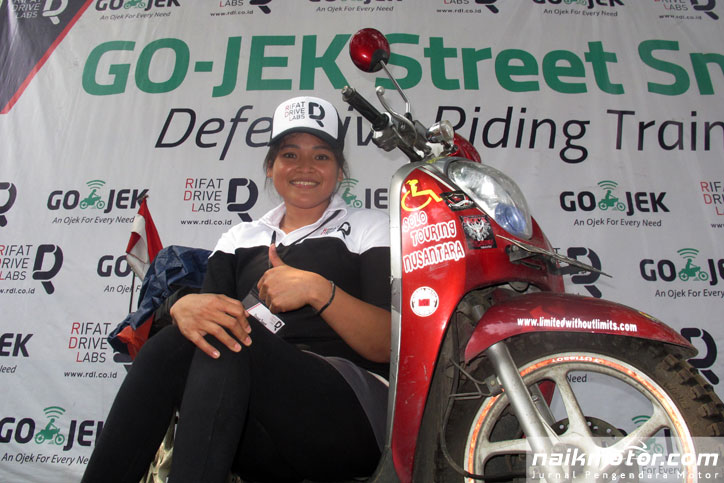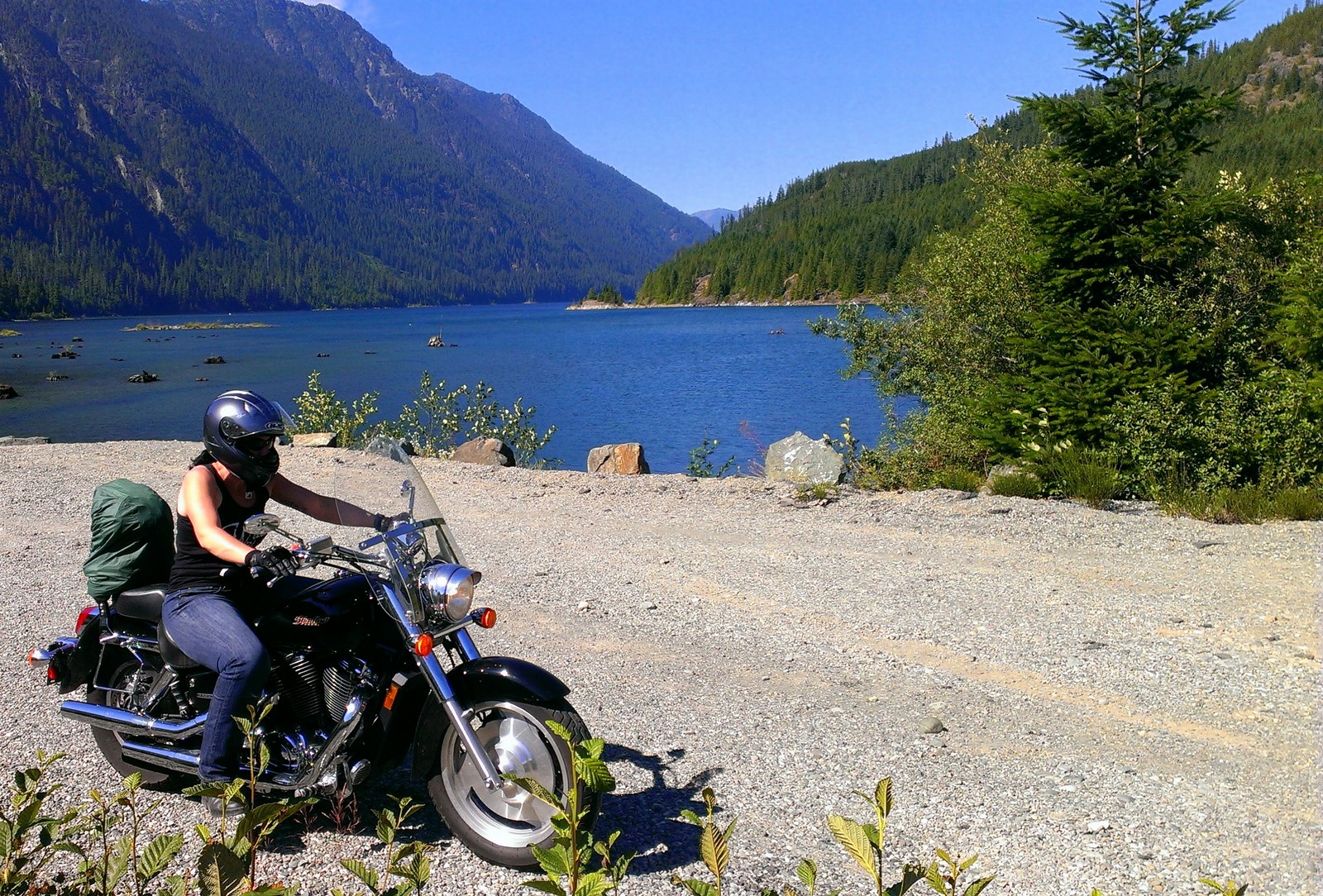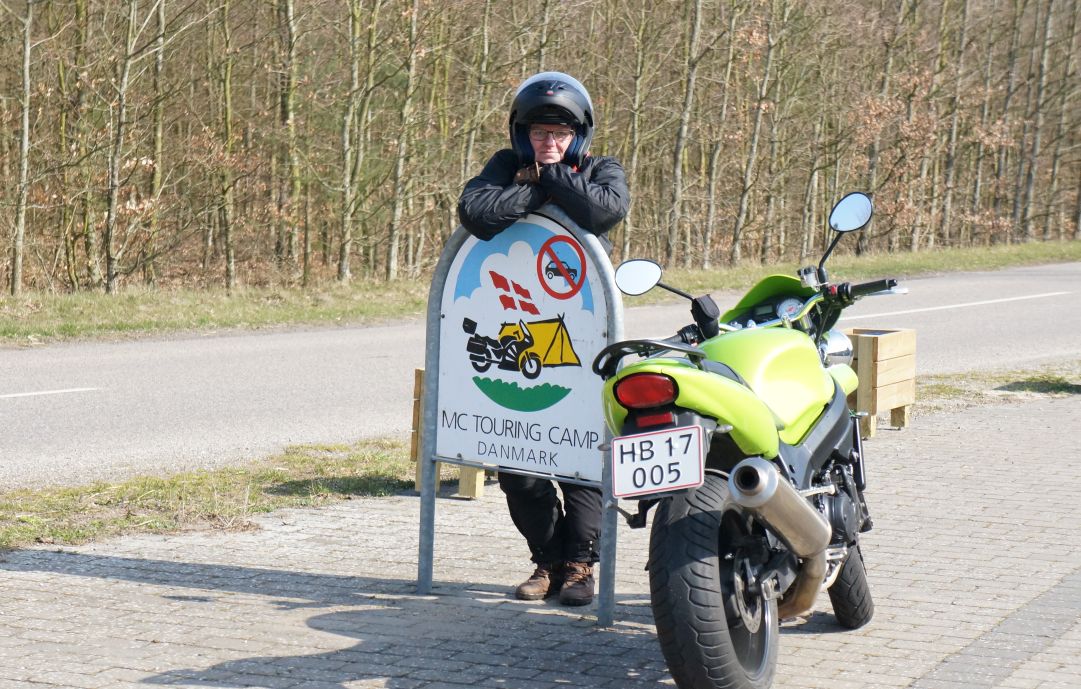Shinta Utami
Shinta Utami is an adventure rider from Indonesia who is currently travelling around her country on a 110 cc Honda scooter. Her scooter is modified to have four wheels at the back to help support her legs which are weakened by post-polio syndrome. Shinta shares with us her stories of riding solo on the archipelago of Indonesia. (Even though Global Women Who Ride focuses on motorcycle riders, we will make an exception for Asian riders since they are far more likely to ride scooters than motorcycles.) [Rashmi Tambe – Editor]

Please introduce yourself. Hello, I’m Shinta. When I was four, I got polio. After the fever subsided, my mother found that I could no longer walk. I was lucky because many victims are paralyzed forever, but eventually I learned to walk again in my own very strange and painful way. I have a walking stick but I don’t have to use a wheelchair or crutches. Now that I am thirty, I have post-polio syndrome. This means that my legs keep getting weaker and I get more and more tired. Some days I can barely walk half a kilometer. Other days it hurts too much to walk only a hundred meters. My scooter is like a new set of legs. I really hope I can travel the world someday on a bigger bike.
How did you get started riding? The first time I learned to ride a two-wheeler, my legs were not strong enough to support a bike. I didn’t know how to ride a bicycle and had a hard time balancing.
Then in 2013, my father took my sister’s old scooter and added two extra wheels to it so that it could stand up on its own. This was my first modified scooter. It is completely different from a two-wheeler but it didn’t take me long to learn to ride it. Having it has allowed me to move around like an able-bodied person. And that is how my passion for travel began. With my scooter, I am able to see and do things that I have always wanted to do.
How did you go from learning to ride that scooter to getting on the road to make your record-making journey? After I got my motorbike, I went touring with friends. Soon after, I decided to ride by myself. In the beginning, I was scared because it meant that I would be alone on the roads but soon I got over it.
I always wanted to travel further before I got to 30, so less than a month before my birthday I decided that – ready or not – I had to go. Indonesia is a very big archipelago and some parts are hard to reach. In the beginning, my plan was just to go to Borneo. After I arrived in Borneo, I started to plan my next route. Basically, after I arrived on one island, I went straight to check the ferry schedule to plan the next section of my route. Ferries often come only once a week, so I had to make sure not to miss one.
Pretty soon, I was on an attempt to make a new record in the Indonesian Records Museum for the longest distance traveled on a modified scooter by a physically challenged person. So far I’ve ridden around 18,000 km in 27 provinces, with 7 more to go. What I like about this journey is the freedom that I feel when riding my bike. I am able to see new places and meet so many people from different cultures. The hardest thing is that because I’m on a small scooter, sometimes I struggle while climbing hills or driving on bad roads.

Tell us a good story from your travels. While riding around Indonesia, I met so many people who had never seen a four-wheeled scooter like mine. Every time I stopped, people would start to come over and ask me questions. Most of the time, I got invited to their houses.
One of my most interesting experiences was when I was in Borneo and I had a problem with my bike because the roads are so bad. My suspension linkage broke and I almost fell off the road and into a gorge. Luckily, some truck drivers helped me and put my bike onto one of their trucks and drove me to the next mechanic’s shop. I made so many friendships with so many truck drivers and I think that they are my favorite.
Did you hit any major problems during your journey? A week before I left, I had prepared everything and brought my bike to a mechanic to check its condition. Two days before my departure, the mechanic broke one of the extra wheels. He tightened the central bolt too hard and the head broke off. He then took a hammer and tried to take the remaining piece out. I was so scared that I wouldn’t be able to leave but I finally decided to continue with my plan and left anyway. As a result of the mechanic mistake, the bolt kept falling off on the road and gave me so much trouble. Eventually, I replaced the entire engine cover in Borneo.
In Indonesia, most of the mechanics don’t go to school and just learn everything by watching other people. Most are not very good and sometimes they do more harm than good to your bike, so make sure you know a little bit about mechanics and always stay and watch when they fix your bike.
Did you experience people trying to over-protect you? There are always two sides to everything. The good thing is that because I am a woman, people are more likely to help me if something is wrong with my bike. I get so many people offering to let me sleep at their house. The bad side is that I cannot always sleep outside or in my tent because people are frequently worried about me. It’s annoying but I understand.
In most places that I visited, people surrounded me and were curious about me and my bike. If they saw a westerner, they would be even more interested and you probably would get thousands of people saying “Hello, mister!” every day.
Can you describe your favorite long distance ride? There was one time in Indonesian Borneo when I was driving through the undeveloped forest all by myself. Maybe only one truck passed by every half an hour and it was really nice to be alone with nature. Most places in Borneo are still palm plantations or part of a national park. When I drove from Tanjung Selor to Samarinda, I went through a National Park for 150-200 km during which I was surrounded only by trees, birds and monkeys on the road.
Is there any other kind of riding that you’d like to try your hand at? I’ve always wanted to ride a dirt bike. Maybe if they modified it for me, someday I could. A dual-sport touring bike is more interesting for me because I would love to go around the world on one.
Do you do maintenance and repairs on your bike? Technically I know how to fix my bike and how to change my tires. But so far people have always helped me out when something went wrong. The benefits of being a woman, I guess. (laughs)
What’s your dream bike? A Honda GL1800 Roadsmith Trike. My dream is to see the world on a bike and I think the Honda would be perfect for that because it would be so comfortable.
Do you have any riding heroes? Valentino Rossi. I have been watched MotoGP since I was in university and I like speed. Valentino Rosi always wins with style and even when he doesn’t start from the first row he always finds a way up to win. If you like speed, you must definitely worship this nine-time World Champion.
Do you have any advice for people who want to start riding? If you fall over, get up and try again. As soon you know how to ride, nothing can stop you.

RIDING IN INDONESIA

If I were to visit you and we went riding for one short morning ride, where would you take me?
I would like to take you to Lembang in West Java. We would drive from Sersan Bajuri, Bandung to Tangkuban Perahu, also in Bandung. This route goes outside the city into the mountains and is really nice. You can see beautiful scenery and tea plantations along the way. [Link to Route]
What’s the best part about riding in your country?
If you forget about the potholed roads, Indonesia is very blessed with so much beautiful scenery. It is a very big country and we are blessed with mountains, beaches, tea plantations and rice paddies.

What kind of food can riders expect to stop for on the way? In Indonesia there are many small shops called warung makan and usually they serve food that is local to the area. Since Indonesia is big country and has so many cultures, different provinces have different foods. E.g. Jakarta is famous for soto betawi (Jakarta beef soup), Yogyakarta is famous for gudeg (made from young jackfruit), Bandung is famous for batagor (made from fish meat with peanut sauce), Bali is famous for ayam betutu (made of chicken with spices inside), and Padang is famous for rendang (made by simmering beef for hours in coconut milk and spices until the liquid has evaporated).
Since we are a tropical country, you can also get all kinds of tropical fruits like mango, guava, durian, rambutan, snake fruit, dragonfruit, coconut and so many more.
If you like to drink, you can try the local spirits. Usually in the villages, you will be served either with fresh palm juice or the distilled juice “SOPI”. The alcohol content varies, so drink at your own risk!
What are the top rides you would recommend? Labuan Bajo to Larantuka, East Nusa Tenggara. Most people who come to Indonesia only know about Bali, Lombok or Komodo Island but they should see all of Indonesia! Flores is so beautiful. I have to admit the roads are difficult because there are thousands of corners but you’ll love it because the scenery is beautiful and people are really nice. [Link to Route]
Is it safe to ride at night? I rarely ride at night. Since Indonesia has bad roads and so many forests, it’s best to not ride at night. In some rural areas in Indonesia, there are bandits at night.
Is motorcycle theft a problem? In cities, it’s a common problem. Make sure you lock your bike well when you park it, even in secure parking areas like inside malls and hotels.
Are there any motorcycle specific laws? Most Indonesians use motorbikes because they are an affordable mode of transportation. We have a lot of freedom to ride and park anywhere and there are no specific motorcycle laws.
How do the police treat motorcyclists? Corruption is really high in my country, so sometimes the police try their best to look for your mistakes so they can get a bribe. But in my trip so far, I have never been stopped by the police.
Can you describe the license test? It includes a theory test and a practical test. It’s very difficult so most people bribe the police to get their driving license.
Do you have access to high quality women’s motorcycling gear in your part of the world? There so many local brands that are good quality and affordable.
What kinds of motorcycling events are held regularly? I am a solo rider and since I am not in any motorcycle club I rarely attend any events. But sometimes along the way, I meet a few bikers and they invite me to attend their events, like when I was in Kendari, Sulawesi.
Are any motorcycle related sports popular where you live and do women actively participate in them? There are some but I have never seen any women ride yet.
How are women motorcycle riders treated by most people and by male motorcyclists? Usually we get an “aww“ comment from people, especially from men. A lot of people are amazed by how far I have ridden my bike all by myself.
Do female and male motorcyclists have the same amount of freedom to pursue motorcycling activities? It’s hard for female motorcyclists to get permission from their family especially if they want to drive far. I have met so many women who want to tour but can’t get permission.
All content on this page is copyrighted to Global Women Who Ride and cannot be reproduced in any format. For permission to re-distribute or re-use any content, contact admin@globalwomenwhoride.com.













Wow. Another inspiring story of a brave woman. Hope your dreams of a GL1800 trike and travelling further will soon become true.
Go Shinta go